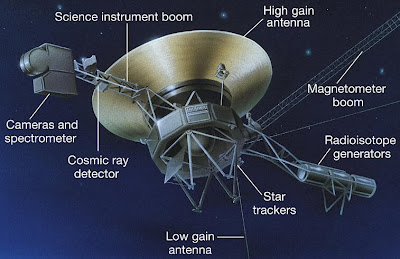August has historically been a notable month for the amazing Voyager 2 probe, an unmanned spacecraft which is classified now as one of the most successful missions in history.

Launched on August 20, 1977, Voyager 2 completed the Planetary Grand Tour, a rare geometric arrangement of the outer planets that occurs every 176 years. It remains the first and only craft to travel to Uranus and Neptune, learning a wealth of new information with varied scientific instruments and powerful cameras.
Voyager 1 and 2 each carried gold-plated phonograph discs, to serve as greetings for any intelligent life. Carl Sagan chaired a selection committee that created a range of scientific data for the records, also visual images, music from different cultures, samples of fifty-five languages, and sounds of nature – such as whalesong, waves, rain, thunder, birds, crickets, a train and a Saturn V rocket launch.

Click to see meaning of the etchings...
By 1979, it grazed the clouds of Jupiter, identifying the Great Red Spot as a mighty anti-cyclonic storm. This exciting time also saw the first close views of Europa, discovery of volcanic activity on Io, and three new Jovian satellites.
On August 25, 1981, Voyager 2 made its closest approach to the planet Saturn, probing the atmosphere to measure exact temperature and density.
Voyager 2 discovered a magnetic field and 10 previously unknown moons of Uranus, and came within 50,600 miles of the planet’s cloud cover to study the unique atmosphere, determine revolution time and examine its young ring system.
The closest approach to Neptune occurred on August 25, 1989, 20 years ago today. The probe took the first accurate measurement of the planet’s mass, and then made a close flyby of the Triton moon.

Voyager 2 crossed into the heliosheath in October 2007, and NASA now uses Voyager 2 to explore interstellar space beyond our solar system.
As of 2009, Voyager 2 is in the constellation Telescopium (as observed from Earth), now more than 8 billion miles from our sun, and is expected to continue transmitting until about 2025.




